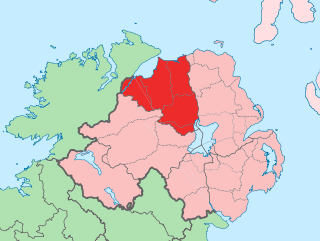
County Londonderry, also known as County Derry, is one of the six counties of Northern Ireland, one of the thirty-two counties of Ireland and one of the nine counties of Ulster. Before the partition of Ireland, it was one of the counties of the Kingdom of Ireland from 1613 onward and then of the United Kingdom after the Acts of Union 1800. Adjoining the north-west shore of Lough Neagh, the county covers an area of 2,118 km2 (818 sq mi) and today has a population of about 252,231.
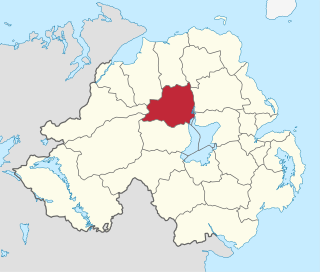
Magherafelt District Council was a district council in County Londonderry in Northern Ireland. It was merged with Cookstown District Council and Dungannon and South Tyrone Borough Council on 1 April 2015 under local government reorganisation in Northern Ireland becoming Mid-Ulster District Council.
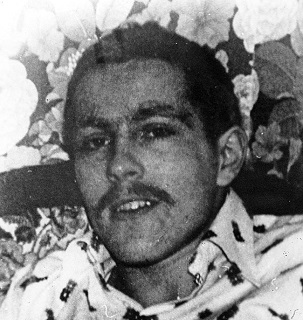
Francis Joseph Sean Hughes was a volunteer in the Provisional Irish Republican Army (IRA) from Bellaghy, County Londonderry, Northern Ireland. Hughes was the most wanted man in Northern Ireland until his arrest following a shoot-out with the British Army in which a British soldier was killed. At his trial, he was sentenced to a total of 83 years' imprisonment; he died during the 1981 Irish hunger strike in HM Prison Maze. Hughes was one of 22 Irish republicans who died on hunger-strike between 1917 and 1981.

Magherafelt is a town and civil parish in County Londonderry, Northern Ireland. It had a population of 9,071 at the 2021 Census. It is the biggest town in the south of the county and is the social, economic and political hub of the area. It is part of Mid-Ulster District.

The Derry County Board of the Gaelic Athletic Association (GAA) or Derry GAA is one of the 32 county boards of the GAA in Ireland. It is responsible for Gaelic games in County Londonderry in Northern Ireland. The county board is also responsible for the Derry county teams.
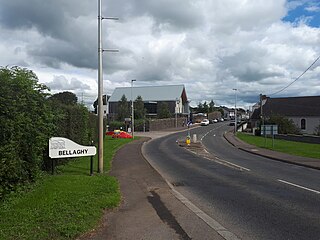
Bellaghy is a village in County Londonderry, Northern Ireland. It lies north west of Lough Neagh and about 5 miles north east of Magherafelt. In the centre of the village three main roads lead to Magherafelt, Portglenone and Toome. It had a population of 1,063 people in the 2001 Census and is within Mid-Ulster District.
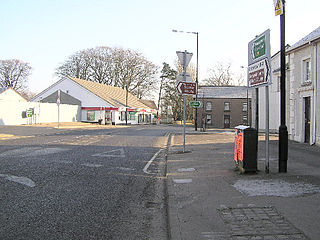
Tobermore, from Irish An Tobar Mór, meaning 'the great well') is a small village in County Londonderry, Northern Ireland named after the townland of Tobermore. The village, which has a predominantly Protestant population, lies 2.5 miles (4.0 km) south-south-west of Maghera and 5.5 miles (8.9 km) north-west of Magherafelt. Tobermore is within the civil parish of Kilcronaghan and is part of Mid-Ulster District. It was also part of the former barony of Loughinsholin.

Knockloughrim or Knockcloghrim is a small village near Maghera in County Londonderry, Northern Ireland. In the 2001 Census it had a population of 186 people. Knockloughrim lies within the civil parish of Termoneeny and is part of the former barony of Loughinsholin. It is situated within the Mid Ulster District Council area.
Patrick Bradley is an Irish sportsman who plays Gaelic football for John Mitchel's Glenullin and the Derry county team. With the county he has won two National League titles, and individually an All Stars Award for his performance in the 2007 All-Ireland Senior Football Championship.
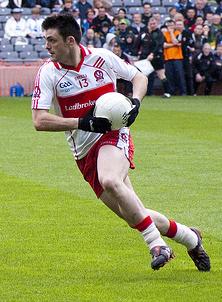
Eoin Bradley is a Gaelic footballer and association footballer. He plays the former for the Glenullin club and, previously, for the Derry county team. With Glenullin he won a Derry Senior Football Championship and with Derry he won a National League title. Bradley usually plays corner forward for both club and county – often paired in a two-man inside forward line with brother Patsy, but has also played in the half-forward line. He is known for his searing pace, point scoring abilities, fantastic goals and surging runs through opposing teams' defence. His "reckless adventure" and liability to do the unexpected is also part of his effectiveness. Although a great talent, in the past he has been criticised for some of his shot selections from ridiculous angles. However, since 2011 his decision-making in front of goal has greatly improved, which has put down to manager John Brennan.
Gerard O'Kane is a Gaelic footballer who plays for the Derry county team, with whom he has won a National League title.
Marian Donnelly is a former president of the Workers' Party and was a member of the former District Policing Partnership for the Magherafelt district of Northern Ireland.
The NMF Properties Derry Senior Football Championship 2009 is the 2009 installment of the annual Derry Senior Football Championship run by the Derry GAA. Ballinderry are the current holders - beating Slaughtneil in the 2008 final at Celtic Park. The winners were awarded the John McLaughlin Cup and went on to represent Derry in the 2009 Ulster Senior Club Football Championship.

Ian Milne is an Irish republican politician from Northern Ireland.
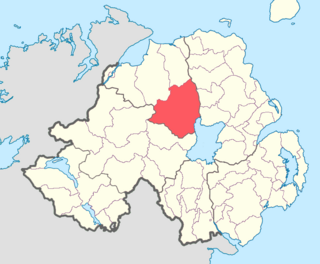
Loughinsholin is a barony in County Londonderry, Northern Ireland. Its southeast borders the northwest shore of Lough Neagh, and itself is bordered by seven other baronies: Dungannon Upper to the south; Strabane Upper to the west; Keenaght and Coleraine to the north; Kilconway, Toome Upper, and Toome Lower to the east. It was formed largely on the extent of the northern part of the medieval Irish túath of Uí Tuirtri.
The High Sheriff of County Londonderry is King Charles III's judicial representative in County Londonderry. Initially an office for lifetime, assigned by the ruling monarch, the High Sheriff became annually appointed from the Provisions of Oxford in 1258. Besides his judicial importance, he has ceremonial and administrative functions and executes High Court Writs.
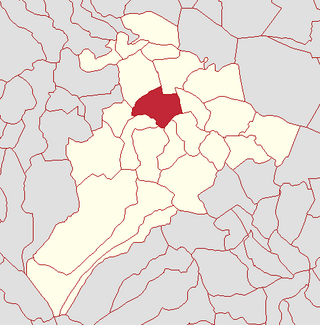
Calmore is a townland lying within the civil parish of Kilcronaghan, County Londonderry, Northern Ireland. It lies in the north-west of the parish, and is bounded by the townlands of; Granny, Moneyshanere, Moyesset, and Tobermore. It was apportioned to the Drapers company as well as Crown freeholds.

That part of the United Kingdom called Northern Ireland was created in 1922, with the partition of the island of Ireland. The majority of the population of Northern Ireland wanted to remain within the United Kingdom. Most of these were the Protestant descendants of settlers from Great Britain.

The Seamus Heaney HomePlace is an arts and literary centre in Bellaghy, County Londonderry, Northern Ireland. It displays the life and work of Seamus Heaney.
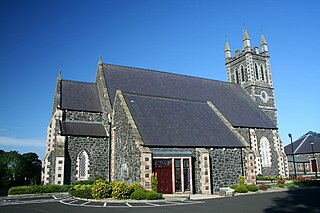
St. Mary's Church is a Roman Catholic church in Bellaghy, County Londonderry, Northern Ireland. It is the final resting place of Nobel Prize in Literature laureate Seamus Heaney. It is also the place where IRA hunger-strikers Francis Hughes and Thomas McElwee are buried.




















